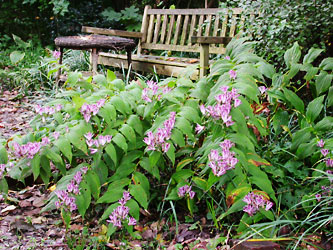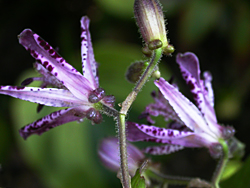

| |
|
|
 |
|
Family: Liliaceae (Lily family) Common Name: "Toad Lily" Origin: Asia - ranging from Nepal eastwards to as far as the Phillipine Islands
Until recently I had no idea how this beautiful plant came to be known as the "Toad Lily". It didn’t seem to be a toad magnet, and it didn't appear to be particularly warty like one. I thought perhaps the speckles on the flowers or spots on the leaves reminded someone of a toad. I hadn’t tried kissing one to see if it turned into a prince, but thought it unlikely, and anyway, it was already a prince to me. It didn't bother me enough to really search out the source of its name; I just called it Tricyrtis! Whatever you call it, this is one knockout plant that deserves a place in every shade garden.
Until only a few years ago Toad Lily was hard to find in the West, but in recent years they have gained popularity. At least ten and possibly as many as eighteen Tricyrtis species exist, and the National Plant Collection® of Tricyrtis in the UK lists 55 Tricyrtis species & cultivars. Native to East Asia, they are reliably hardy in zone 7 and most species are hardy into zone 5. Most well-stocked nurseries sell at least one variety of Tricyrtis hirta, but a better selection can be found in specialty catalogs. Each nursery generally carries one or several species or hybrids but different nurseries offer different ones, so if you shop around, your garden will soon be home to several of these unique, lovely plants. You will want to plant Toad Lily in a location where the flowers can be seen up close. If the variety is one that arches heavily as in the photo at the top of this page, consider placing it next to something it can cascade over such as the top of a wall, fallen logs, or on a raised area. When preparing a planting site, dig in lots of organic material such as peat, soil conditioner, compost, and well-composted manure. Hostas and ferns make excellent companion plants. Begonia grandis ("Hardy Begonia"), with red and pink in the stems and leaves makes a showy companion as does white-flowered Eupatorium, such as the variety “Chocolate”. General Culture: Tricyrtis prefers moist, rich, humusy soil, but they are very adaptable to less than ideal conditions. They will survive and even flower following drought conditions; however the foliage will probably suffer turning brown and decidedly unattractive. If you want them to look their best, plant them in the shade and keep them watered. You will be happy and your Toad Lilies will reward you for your effort. Most bloom in autumn making them valuable for subtle color when little else is flowering. I have one species that starts blooming in mid to late summer and finishes up about the time the others begin. Terrifically heat tolerant and (once established) very drought-tolerant, combined with a low incidence of pest problems, makes Tricyrtis an excellent choice for the low- maintenance landscape. Size: Plant height varies from a few inches to four feet and the width can be from about one foot to a whopping five feet. Light: They perform best when planted in partial to deep shade - the same conditions optimal for Hostas and Hellebores which makes them excellent companion plants. Hardiness: They are reliably hardy in USDA zone 7 and most species are hardy into zone 5. Moisture: The plants’ watering needs are similar to most other shade perennials like Hostas and Helebores. A light mulch will help retain moisture and keep the roots cool during the summer. Propagation: Tricyrtis is very easy to grow from seeds. I sow my seeds in pots outside over the winter, and let mother nature do the rest. The seeds germinate in mid-spring and may flower the first year. Tricyrtis are also easy to propagate by cuttings. They root at the nodes, so be sure that your cuttings have at least one node. Flowers: The flowers look somewhat like a cross between an orchid and passion flower. Usually white but sometimes yellow in color and with various colored speckles, the individual flowers are relatively small compared to the plant, but the number of blooms makes up for their size. Leaves: Foliage ranges from waxy, broad shiny leaves, hairy, dark green, to golden and variegated. Insects and Diseases: This plant has no major insect or disease problems, however, slugs may eat holes in the leaves, so be on the lookout for them. |
|

